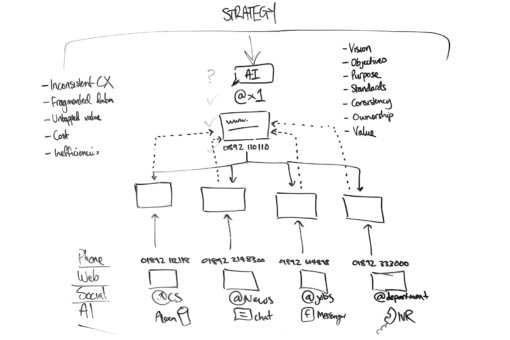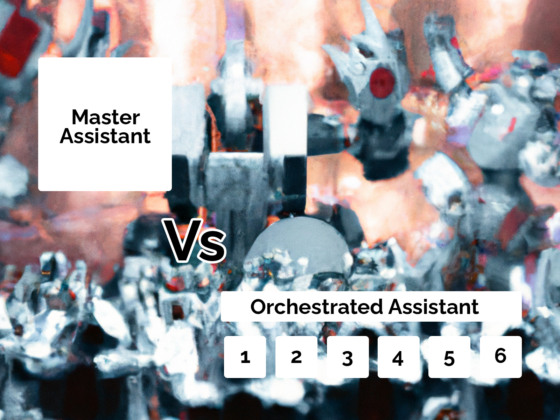Here’s a tell tale sign that it’s time to put together a proper conversational AI strategy for your company.
Voice and conversational AI is in danger of going down the same route as call centres, websites and social media did in the early days, leading to sunken costs, inefficient management, poor customer experience and ineffective results.
You’ll avoid this with a proper conversational AI strategy that’s woven into your core organisational strategy, but you first need to spot the signs that it’s needed.
The Problem
Remember when companies used to have multiple Twitter accounts that catered for different customer needs? One account for customer service, another for news and updates, another for recruitment.
These accounts weren’t set up because of a need from the user to have fragmented access. Users don’t need or want to have to deal with multiple different Twitter accounts to get their query resolved. Just like they don’t want to have to call different phone numbers to speak to the right department or search multiple different websites to get what they need.
Fragmented, channel-specific implementations owned by individual teams shows that there’s a potential customer need and an awareness from parts of the business of an opportunity. But it comes at a cost to the customer and the business if it’s not managed centrally as part of a proper purposeful strategy.
History repeats itself with voice and conversational AI
History does repeat itself and we’re seeing the same things start to happen with voice and conversational AI. Multiple teams deploying their own in-channel conversational AI.
The social media team might have a Facebook bot. The marketing team might be experimenting with Alexa and Google Assistant. The IT team might be working with Customer Services to implement an IVR bot and the Digital Team maybe working on a chat bot for the website.
There is nothing wrong with having multiple bots across multiple channels. In fact, this is inevitable when you implement a conversational AI strategy. The problem is when all of those bots are managed independently by a whole load of different teams, with different purposes, different cultures and different goals.
The drawbacks of a siloed voice and conversational AI strategy
Having multiple bots managed by multiple teams means that:
- Customers have an inconsistent experience. Both in terms of what they’re able to do i.e. if the website chat bot doesn’t do the same things as the Facebook messenger bot, and in terms of how it interacts i.e. different designers working to different briefs producing different customer experiences across each channel.
- Data is fragmented. If your Facebook bot is sending data to your social team, your Alexa skill to your sales team and your chatbot to your web team, you’re not gathering learnings from across the board. You can’t understand how effective conversational AI actually is without going to three different places to view the details.
- Business value is untapped. If your website chatbot is doing something really well, wouldn’t it be good to extend that into your IVR? Or onto Alexa? Individual departments managing individual channels means that no one is focusing on making sure the business extracts maximum value from the entire operation.
- It’s more expensive. This one is obvious, but creating and managing conversational AI agents isn’t free. Even if you built them all internally, it costs. You have staff costs, licensing and software costs, potential partnership or agency costs. If you don’t build centrally and deploy across channels, you’ll be spending far more on it than you should.
- You’re duplicating effort. As well as paying more, you’re wasting resources. All of the AI training, the design, the development, the testing, the analysis, the iterations; all of it duplicated by the amount of bots you have and the amount of teams managing them. For some, that might only be two, but even that is duplication enough. If you don’t have a strategy and you allow any team to spin-up any bot, it’s only a matter of time before you’re duplicating substantial efforts across the business.
Depending on your culture, if you let things go too far down that route, it can be hard to implement a consistent strategy, even if you wanted to. People get comfortable. Defensive, even.
Start with a conversational AI strategy
This is why you should start from the beginning with a conversational AI strategy that has the following:
- Ownership. As nice as it is to have empowered teams across the organisation, the buck needs to stop with someone. Without a person being responsible for it, you leave too much room for inconsistency, de-prioritisation and chaos. You need a lynchpin, a champion and a driver; without it being someone’s job to own it, make sure it’s a success and steer the ship, you’ll just keep drifting.
- Vision. You need to know where you want to get to and have a vision for that which you can share with the organisation. Like it or not, individuals within the organisation have their own agendas and influence. You need to be able to enthuse and empower key stakeholders with a compelling vision that the organisation can buy into and support.
- Objectives that are aligned to core business goals. Yes, it’s fine to experiment and learn. It’s fine to have baselines rather than targets. But all roads should lead to Rome. It should all be done on purpose with the aim of finding value for the business. And it doesn’t have to be cost savings and efficiencies. It can be incremental revenue, loyalty, delightful customer feedback, whatever matters to your business.
- Standards. Standards for what good design looks like. Standards for how you speak. Standards for the processes you follow. Standards for how you build, test and deploy new use cases consistently across all channels. Standards for the technology you use, build and buy. Standards for the partners you engage with. Standards for how you gather, store and use data. Having standards will allow you to keep quality high and customer experience consistent.
You already have (or should have) this stuff in your digital strategy, it’s a case of iterating it to include conversational AI. Yes, conversational AI should just be part of the wider organisational strategy!
Once you have the foundations in place, you can then plan how you’ll explore, experiment, implement and grow your conversational AI capability across all customer touch points. You don’t have to conquer the world straight away, but you need to start in the right place, with purpose.
You may still have different bots in different channels that specialise in certain areas. They might not all do exactly the same thing, but they’ll have parity where needed and consistency in their appearance and experience.
You’ll save costs and effort, consolidate your learnings easily, as well as be able to move a heck of a lot quicker in response to what you do learn.
A siloed approach works in the extreme short term, but it’ll hurt you eventually. Get a strategy, please.
You can get started with your conversational AI strategy in less than a week with our conversational automation strategy sprint.





